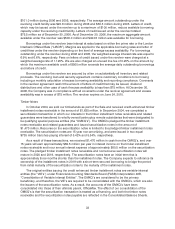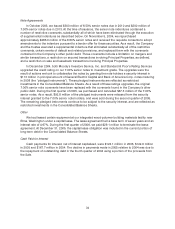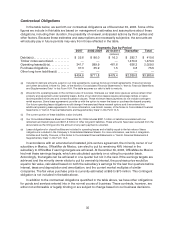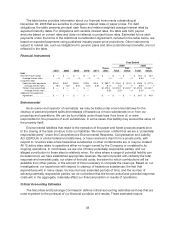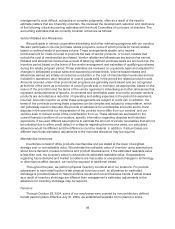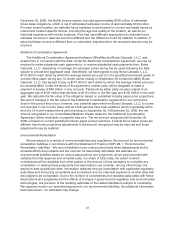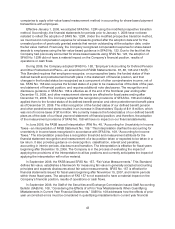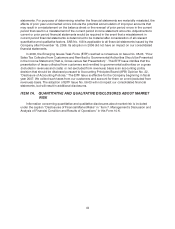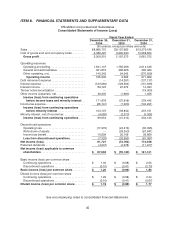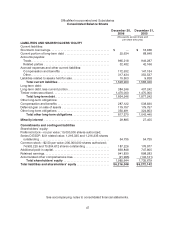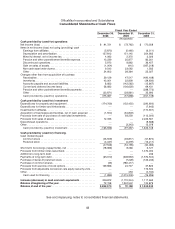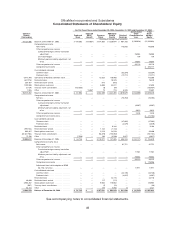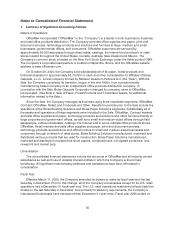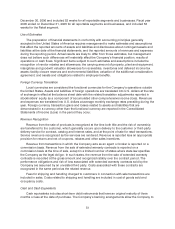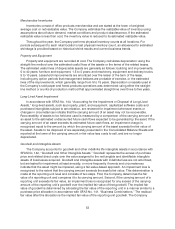OfficeMax 2006 Annual Report Download - page 47
Download and view the complete annual report
Please find page 47 of the 2006 OfficeMax annual report below. You can navigate through the pages in the report by either clicking on the pages listed below, or by using the keyword search tool below to find specific information within the annual report.43
companies to apply a fair-value-based measurement method in accountingfor share-based payment
transactions with employees.
Effective January 1, 2006, we adopted SFAS No. 123R using the modified prospective transition
method. Accordingly, the financial statements for periods priorto January 1, 2006 have not been
restated to reflect the adoptionof SFAS No. 123R. Under the modified prospective transitionmethod,
we must record compensation expense for all awards granted after the adoption date and for the
unvested portionof previously granted awards that remain outstanding atthe adoption date, under
the fair value method. Previously, the Company recognized compensation expense forshare-based
awards to employees using the fair-value-based guidancein SFAS No. 123. Due to the fact that the
Company had previously accounted for share-based awards using SFAS No. 123, theadoptionof
SFAS No. 123R did not have a material impact on theCompany’s financial position, results of
operations or cash flows.
During 2006, the Company adopted SFAS No. 158, “Employer’s Accounting for DefinedPension
and Other PostretirementPlans—an amendment of FASB Statements No. 87, 88, 106and 132(R).”
This Standard requires that employersrecognize, on a prospective basis, thefunded status of their
defined benefit and postretirement benefit plans in the statement of financial position, and that
changes in the funded status be recognized as acomponent of other comprehensive income, net of
tax. SFAS No. 158 also requires the funded status of a plan to be measured a s of the date of the year-
end statement of financial position, and requires additional note disclosures. Therecognition and
disclosure guidance in SFAS No. 158 is effective as ofthe end of the first fiscal year ending after
December 15, 2006, and other measurement elements are effective for fiscal years ending after
December 15, 2008. The Company adopted the recognition provisions of SFAS No. 158 andinitially
applied themto the funded status ofits defined benefit pension and other postretirement benefit plans
as of December 31, 2006. The initial recognition of the funded status of our defined benefit pension
and other postretirement plans resulted in an increase inShareholders’ Equity of $11.9 million, which
wasnet of income taxes of $7.6 million. We currently measure the funded status of ourdefined benefit
plans as of the date of our fiscal year-end statement of financial position, and therefore, the adoption
of themeasurement provisions of SFAS No. 158 willhave no impact onour financial statements.
In June 2006, the FASB issued Interpretation (FIN) No. 48, “Accounting for Uncertainty in Income
Taxes—an interpretation of FASBStatement No. 109.” This Interpretationclarifies the accounting for
uncertainty in income taxes recognized in accordance with SFAS No. 109, “Accounting for Income
Taxes.” The Interpretation prescribes a recognition threshold and measurement attribute for the
financial statement recognition and measurement of a tax position taken or expected to be taken in a
tax return. It also provides guidance onderecognition, classification, interest and penalties,
accounting in interim periods, disclosureand transition. The Interpretation is effectivefor fiscal years
beginning after December 15,2006. TheCompany is in theprocess ofevaluating the impact of
applying the provisions ofthe Interpretation to all tax positions and currently anticipates the impact of
applying the interpretation will not be material.
In September 2006, the FASB issued SFAS No. 157, “Fair Value Measurements.” This Standard
defines fair value, establishes a framework for measuring fair value in generally accepted accounting
principles and expandsdisclosures about fair value measurements. SFAS No.157 is effective for
financial statements issued for fiscal years beginning after November 15, 2007, and interim periods
within those fiscal years. The adoptionof FAS 157 is not expected to have a material impact on the
Company’s financial position, results of operations or cash flows.
In September 2006, the Staff of the Securities and Exchange Commission issued Staff Accounting
Bulletin(SAB) No. 108, “Considering the Effects of a Prior Year Misstatements When Quantifying
Misstatements in CurrentYear Financial Statements.” SAB No. 108 addresses how the effects of prior
year uncorrected errors must be considered in quantifying misstatementsin current year financial


